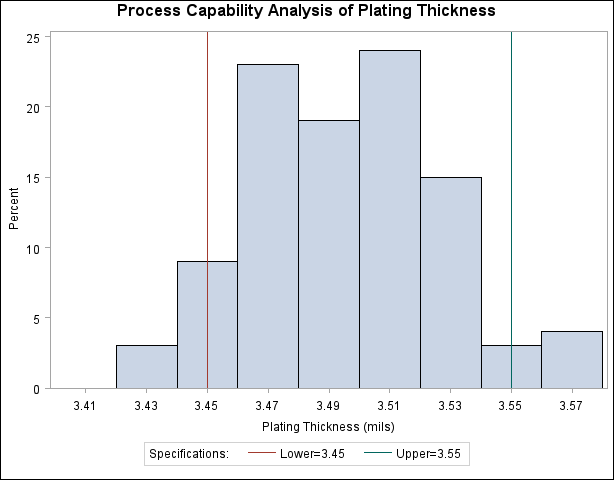| The CAPABILITY Procedure |
Creating a Histogram with Specification Limits
[See CAPHST1 in the SAS/QC Sample Library]A semiconductor manufacturer produces printed circuit boards that are sampled to determine whether the thickness of their copper plating lies between a lower specification limit of 3.45 mils and an upper specification limit of 3.55 mils. The plating process is assumed to be in statistical control. The plating thicknesses of 100 boards are saved in a data set named Trans, created by the following statements:
data Trans; input Thick @@; label Thick='Plating Thickness (mils)'; datalines; 3.468 3.428 3.509 3.516 3.461 3.492 3.478 3.556 3.482 3.512 3.490 3.467 3.498 3.519 3.504 3.469 3.497 3.495 3.518 3.523 3.458 3.478 3.443 3.500 3.449 3.525 3.461 3.489 3.514 3.470 3.561 3.506 3.444 3.479 3.524 3.531 3.501 3.495 3.443 3.458 3.481 3.497 3.461 3.513 3.528 3.496 3.533 3.450 3.516 3.476 3.512 3.550 3.441 3.541 3.569 3.531 3.468 3.564 3.522 3.520 3.505 3.523 3.475 3.470 3.457 3.536 3.528 3.477 3.536 3.491 3.510 3.461 3.431 3.502 3.491 3.506 3.439 3.513 3.496 3.539 3.469 3.481 3.515 3.535 3.460 3.575 3.488 3.515 3.484 3.482 3.517 3.483 3.467 3.467 3.502 3.471 3.516 3.474 3.500 3.466 ; run;
The following statements create the histogram shown in Figure 5.7.2:
title 'Process Capability Analysis of Plating Thickness'; legend2 frame; proc capability data=Trans noprint; spec lsl = 3.45 usl = 3.55; histogram Thick / legend = legend2; run;
A histogram is created for each variable listed after the keyword HISTOGRAM. The SPEC statement, which is optional, provides the specification limits that are displayed on the histogram. For more information about the SPEC statement, see Syntax for the SPEC Statement.
The NOPRINT option suppresses printed output with summary statistics for the variable Thick that would be displayed by default. See Computing Descriptive Statistics for an example of this output.

Copyright © SAS Institute, Inc. All Rights Reserved.